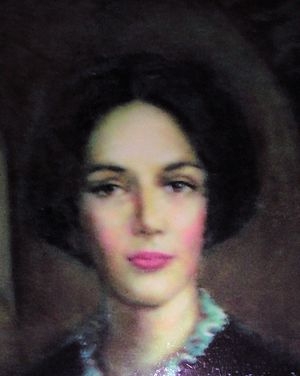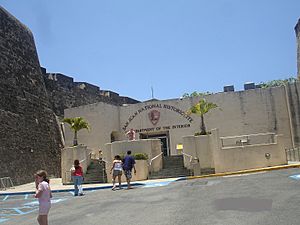María de las Mercedes Barbudo facts for kids
María de las Mercedes Barbudo (born in 1773 – died in 1849) was a brave Puerto Rican leader. She was the first woman on the island to openly support Puerto Rico becoming independent. People called her a "Freedom Fighter" because she worked hard for her country's freedom. At that time, the movement for Puerto Rican independence was connected to rebels in Venezuela, led by a famous leader named Simón Bolívar.
Contents
Early Life and Education
María de las Mercedes Barbudo y Coronado was born in San Juan, the capital city of Puerto Rico. Her father, Domingo Barbudo, was from Spain and served as an officer in the Spanish Army. Her mother, Belén Coronado, was Puerto Rican.
Because her father was a military officer, María had a special chance to get an education. She was one of the few girls in Puerto Rico who learned to read and could buy books. Back then, only Spanish government officials or very rich landowners had access to libraries and books. Most poor people learned stories through songs and poems called Coplas and Décimas.
María was very well-educated and became interested in politics and helping her community.
Becoming a Political Activist
As a young woman, María Barbudo started her own business in San Juan. She sold sewing supplies like buttons, threads, and clothes. She became very successful and even lent money to people. She did business with important people, including Joaquín Power y Morgan.
María was part of important social groups. She met famous people like Captain Ramón Power y Giralt, Bishop Juan Alejo de Arizmendi, and the artist José Campeche. She had modern ideas and often invited thinkers to her home. They talked about Puerto Rico's political, social, and economic problems. They also discussed ways to make life better for everyone.
María was inspired by Simón Bolívar, a leader who dreamed of uniting all of Latin America, including Puerto Rico and Cuba. She believed in independence for Puerto Rico. Bolívar wanted to create a group of independent countries in Latin America, similar to the United States. He also wanted to make sure people had individual rights.
María became friends with many Venezuelan revolutionaries. She wrote letters to them, especially to José María Rojas. She also received newspapers and magazines from Venezuela that shared Bolívar's ideas.
Arrested for Her Beliefs
The Spanish leaders in Puerto Rico, led by Governor Miguel de la Torre, became suspicious of María. They knew she was writing to Venezuelan rebels. Spanish secret agents secretly read some of her letters and gave them to the Governor. He ordered her mail to be taken away and started an investigation.
The government thought María's letters were spreading ideas that would make Puerto Ricans want independence. They believed her actions could lead to a rebellion.
Governor Miguel de la Torre ordered María's arrest. She was accused of planning to overthrow the Spanish government in Puerto Rico. María was held at the Castillo (Fort) de San Cristóbal, a fort, because there was no prison for women on the island.
One piece of evidence against her was a letter from José María Rojas, dated October 1, 1824. In the letter, Rojas mentioned that the Venezuelan rebels had lost an important contact in Saint Thomas. This meant their secret communication with Puerto Rican independence leaders was at risk.
On October 22, 1824, María appeared before a judge. The government showed letters from Rojas and several newspapers that supported Bolívar's ideas. When asked if she recognized the letters, she said yes but refused to answer more questions. The government also showed pamphlets that spoke against the Spanish monarchy. María was found to be working against the government.
Exile and New Beginnings
Governor de la Torre discussed María's situation with the prosecutor. It was decided that she should be sent away from Puerto Rico to Cuba. On October 23, 1824, María was placed under house arrest at the Castillo de San Cristóbal.
The next day, María asked the governor for time to take care of her personal and financial matters before leaving. But her request was denied. On October 28, she was put on a ship called El Marinero.
In Cuba, María was kept in a place for women accused of different things. But with help from other revolutionaries, she managed to escape. She traveled to Saint Thomas Island and then finally reached La Guaira in Venezuela. Her friend José María Rojas met her there.
They went to Caracas, where María met Simón Bolívar himself. She became close with members of Bolívar's team, including José María Vargas, who later became the fourth president of Venezuela. María worked closely with them.
Legacy and Recognition
María de las Mercedes Barbudo never married or had children. She also never returned to Puerto Rico. She passed away on February 17, 1849. She was buried in the Cathedral of Caracas, right next to Simón Bolívar. Being buried in the Cathedral was a great honor, usually only given to important church leaders or very wealthy people.
In 1996, a documentary film was made about her life. It was called Camino sin retorno, el destierro de María de las Mercedes Barbudo (Road of no return, the exile of María de las Mercedes Barbudo). Sonia Fritz produced and directed this film.
See also
 In Spanish: María de las Mercedes Barbudo para niños
In Spanish: María de las Mercedes Barbudo para niños
- List of Puerto Ricans
- History of women in Puerto Rico
- Antonio Valero de Bernabé
- Ducoudray Holstein Expedition
19th Century Female Leaders of the Puerto Rican Independence Movement
Female Members of the Puerto Rican Nationalist Party
- Blanca Canales
- Rosa Collazo
- Lolita Lebrón
- Ruth Mary Reynolds
- Isabel Rosado
- Isabel Freire de Matos
- Isolina Rondón
- Olga Viscal Garriga
Articles Related to the Puerto Rican Independence Movement
- Puerto Rican Nationalist Party Revolts of the 1950s
- Puerto Rican Nationalist Party
- Ponce massacre
- Río Piedras massacre
- Puerto Rican Independence Party
- Grito de Lares
- Intentona de Yauco
- Ruben Berrios
- Maria de Lourdes Santiago



